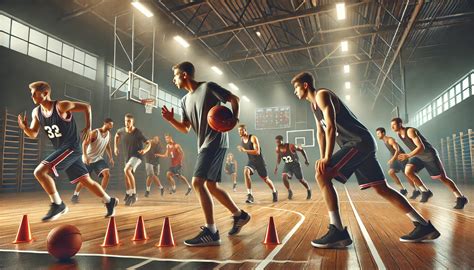The Art of Basketball Stamina: Training and Techniques
Basketball is a game of explosive bursts and relentless effort. While skill and strategy are crucial, stamina is the unsung hero that determines a player's ability to perform at a high level for the entire game, and even throughout a grueling season. Developing exceptional basketball stamina isn't just about running more; it's a strategic approach combining cardiovascular fitness, strength training, and smart recovery techniques. This article delves into the art of building basketball stamina, exploring effective training methods and techniques.
What are the Key Components of Basketball Stamina?
Basketball stamina isn't simply about endurance; it's a multifaceted concept encompassing several key components:
- Cardiovascular Endurance: The ability of your heart and lungs to deliver oxygen to your muscles during prolonged exertion. This is crucial for sustaining high-intensity movements throughout the game.
- Muscular Endurance: The capacity of your muscles to repeatedly contract and generate force without fatiguing quickly. This allows you to maintain defensive pressure, rebound effectively, and execute offensive plays consistently.
- Anaerobic Capacity: The ability to produce energy without oxygen for short, intense bursts of activity, like sprints and quick changes of direction. This is vital for reacting to fast-paced plays.
- Mental Toughness: The psychological resilience to push through fatigue and maintain focus under pressure. This is often overlooked, but equally important.
How to Improve Basketball Stamina: Training Strategies
Building basketball stamina requires a comprehensive training program that addresses all the key components mentioned above. Here are some effective strategies:
1. Interval Training: Mimicking Game Conditions
Interval training is arguably the most effective way to build basketball-specific stamina. It involves alternating high-intensity periods with periods of rest or low-intensity activity. Examples include:
- Suicides: Sprinting to designated lines and back, progressively increasing distance.
- Shuttle Runs: Running back and forth across a court, mimicking the constant movement of a game.
- Sprint Drills: Combining sprints with ball-handling drills to improve agility and stamina simultaneously.
These drills mimic the stop-and-go nature of basketball, improving both your anaerobic and cardiovascular fitness.
2. Strength Training: Building a Foundation
Strength training is often underestimated, but it's vital for developing muscular endurance and injury prevention. Focus on compound exercises that work multiple muscle groups simultaneously:
- Squats: Strengthen legs and core for jumping, quick changes of direction, and rebounding.
- Deadlifts: Improve overall power and strength for explosive movements.
- Lunges: Enhance leg strength and stability.
- Push-ups and Pull-ups: Build upper body strength for shooting, passing, and defense.
Remember to use proper form to avoid injuries.
3. Plyometrics: Explosiveness and Agility
Plyometrics focuses on explosive movements that improve power and agility – essential for basketball. Exercises include:
- Box Jumps: Develop explosive leg power for jumping and rebounding.
- Jump Squats: Improve both power and leg strength.
- Lateral Bounds: Enhance lateral agility and quickness.
Plyometrics should be incorporated gradually to avoid injury.
4. Endurance Running: Building a Base
While interval training is crucial, incorporating longer, steady-state cardio sessions helps build a solid cardiovascular base. This could include running, cycling, or swimming. These sessions improve your aerobic capacity and help you recover faster between high-intensity intervals.
Nutrition and Hydration: Fueling Your Performance
Proper nutrition and hydration are crucial for optimal stamina. Focus on:
- Carbohydrate Intake: Provides energy for your workouts and games.
- Protein Intake: Supports muscle repair and growth.
- Hydration: Prevents dehydration, which significantly impacts performance. Drink plenty of water throughout the day, especially before, during, and after training.
Recovery: The Often Overlooked Factor
Rest and recovery are just as important as training. Adequate sleep, proper nutrition, and active recovery methods like stretching and foam rolling are essential for preventing injuries and optimizing performance.
How Much Stamina Training Should I Do?
The amount of stamina training you need depends on your current fitness level and the intensity of your basketball activities. A well-structured program should gradually increase the duration and intensity of your workouts over time. Consult with a fitness professional or athletic trainer to create a personalized plan.
What are some common mistakes people make when training for basketball stamina?
Overtraining: Pushing yourself too hard too soon can lead to injury and burnout. Gradual progression is key.
Neglecting Strength Training: Focusing solely on cardio neglects the muscular endurance crucial for basketball.
Ignoring Proper Nutrition and Hydration: Fueling your body correctly is vital for optimal performance and recovery.
Lack of Rest and Recovery: Adequate rest is essential to allow your body to repair and rebuild.
What are some advanced training techniques for basketball stamina?
High-Altitude Training: Training at higher altitudes increases red blood cell production, leading to improved oxygen carrying capacity.
Lactate Threshold Training: Training at intensities that push your lactate threshold helps improve your ability to sustain high-intensity efforts.
Fartlek Training: This involves varying the pace and intensity of your runs throughout your workout, simulating the unpredictable nature of a game.
By implementing these training strategies and prioritizing recovery, players can significantly improve their basketball stamina, leading to enhanced on-court performance and a more enjoyable game. Remember consistency and a holistic approach are key to success.

